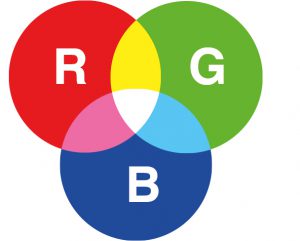
So whats the problem then? the usual culprit is that most images are saved in RGB format when downloaded from digital sources which are ideal if used for websites, but not so great for printed medium.
RGB colour is known as additive colour because it starts as black and colours only appear when wavelengths of light emit from its source. It is the colour model for transmitted light, in other words, anything that originates directly from a specific light source uses RGB, monitors, televisions and digital cameras all use the RGB colour model. When all the colours are added together this achieves white; subtract one or more wavelengths and the outcome results in a colour that we can identify with.
Colour comes from light; the main source of light for us is the sun, even though we can’t see the light we know the colours are present, a rainbow is evidence for this, turning off the light source will result in black.
CYMK is the exact opposite of RGB, it is known as subtractive. Subtractive colour begins as white light from its source, however, as light shines on an object some of those wavelengths are absorbed.
The resulting effect is that we only observe the reflected light which our brains perceive as colour.
A red tomato absorbs blue and green light but reflects the red. Cyan ink absorbs red light but transmits green and blue, the magenta ink absorbs green light but transmits red and blue, and the yellow ink absorbs blue light but transmits red and green.
CMYK is the common colour model for printing ink. It is made up from cyan, magenta, yellow and black.
The black plate is known as the key plate, this is because it provides the contrast and lines for the image.
The general rule is if your work is to be displayed on a monitor, the preferred colour mode is RGB.
If the artwork is to be printed then the preferred colour mode is CMYK.
